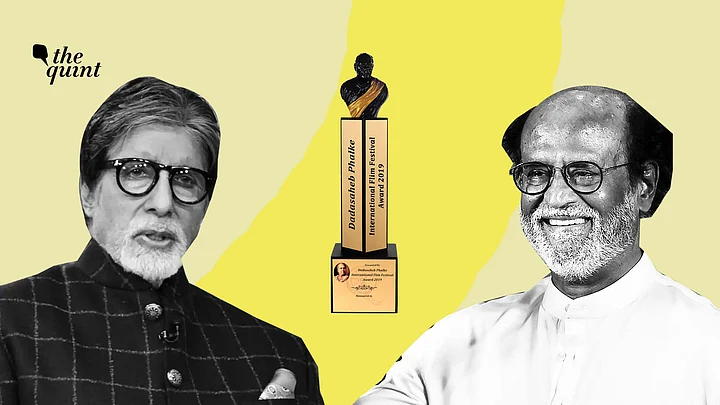On 1 April, the government announced that the Dadasaheb Phalke award for the year 2019 would be awarded to the demigod of Tamil cinema, Rajinikanth. For over four decades, the actor has been a dominating figure in Indian cinema and the award is richly deserved.
A quick look though, at the former recipients of what is India’s highest film honour throws up a glaring problem: the last time a woman was deemed worthy enough of the award happened 21 years back.
Award By Men, For Men?
Ironically, the first ever recipient of the award after its inception in 1969 was legendary actor Devika Rani, often referred to as the ‘First Lady’ of Indian cinema. In the two decades that followed, there were four more women who made the cut, mostly from the Hindi and Marathi industries, with one lone Bengali winner. It’s the last thirty years that have seen a solitary woman, Asha Bhosle (in 2000), as a blip in what can only be described as an award that’s (possibly) by men, for men.
While one doesn’t know how these winners are picked, it’s clear that the ones picking think only men – actors, musicians, producers and directors – have made any ‘outstanding contribution to the growth and development of Indian cinema/’
A decade ago, nobody would have considered any of this a big deal. Over the past few years though, there’s more and more talk about female representation in our films. Influential female actors have become more vocal about things like equal pay, and don’t hesitate to call out the rampant sexism in an industry that’s gone through a #Metoo reckoning a couple of years back. Studios that consider themselves trendsetters, both on and off screen, claim that representation is now a top priority, both on set and in positions of power.
Glass Ceiling Too Far to Shatter?
So why is it then, that the glass ceiling still seems so far away? Ormax Media and Film Companion's O Womaniya! 2021 report on representation of women in Indian cinema paints a picture so bleak that one has to wonder if all that is being said is just lip service. The report is based on an analysis of 129 top-grossing films in 2019-20 across five languages – Hindi, Tamil, Telugu, Malayalam, Kannada – and zeroes in on the exact percentage of women across key portfolios.
Whether it’s the fact that 84 percent of HODs in Hindi cinema are male (this number is 99% in South-Indian cinema) or that only 2 percent of all cinematographers in the country are women, there seems to be no doubt that the bar is currently very low.
And if the crew is largely male, it doesn’t take a genius to figure that most of the content they’re churning out leans that way as well – 59 percent of these films didn’t have a single scene in which two named female characters are having a conversation that’s not about a man/men.
Is it any surprise then that an award category that celebrates an individual’s lifetime contribution to the industry completely ignores women?
Without getting into how deserving or not the forty-five male recipients of the award till date are, would it be misguided philogyny to think that for every V Shantaram on that list, there is a Fatma Begum who’s been long-forgotten. How about Waheeda Rehman then or the late Suchitra Sen? Or the late Bhanu Athaiya? Vijayinthimala maybe? Sai Paranjpye, you say.
The list of women who have powered great cinema in this country is a long one, but the list of patriarchs pulling the strings seems to be a longer one.
Not An Indian Phenomenon Alone
It’s a little reminiscent of the fiasco at the Oscars last year, when they shut out women directors completely. The 2020 Oscars nominations stirred up controversy almost immediately after they were revealed in January.
After what was then called a “banner year” for women in films, none of the five Academy nominees for best director were female. Presenter Issa Rae summed up the feelings of many Oscars observers after announcing the contenders for best director, saying flatly, “Congratulations to those men.”
At the ceremony, Natalie Portman wore a Dior cape with names of the snubbed female directors as a way of paying tribute to them.wore a Dior cape with names of the snubbed female directors.
The hue and cry seemed to have delivered results when the nominations for the 2021 Oscars were announced. For the first time ever in the Academy’s history, two women – Chloe Zhao (Nomadland) and Emerald Fennell (Promising Young Woman) – have been nominated in the Best Director category.
Including them, 70 women have landed 76 nominations, which is a record of sorts for the awards. And having watched most of this content, not one of these is undeserved. It’s just that it took the outrage of one half of that industry to get people to even notice their work.
As the country that churns out the highest number of films in the world, maybe it’s collective outrage that we need – on a level that’s never been seen before.
In 1913, when Dadasaheb Phalke introduced a female actor (Kamlabai Gokhale) in a leading role in his film Mohini Bhasmasur, he broke a ceiling. Till then, all female roles in theatre and films were played by men. This was a time when it was taboo for women to do any kind of work outside their kitchens, leave aside acting, which was anyway seen as a disreputable profession. It’s unfortunate then, that an award instituted in the glory of this man continues to ignore the contributions of women.
(Karishma Upadhyay is a journalist and author of ‘Parveen Babi: A Life’. This is an opinion piece and the views expressed above are the author’s own. The Quint neither endorses nor is responsible for the same.)
(At The Quint, we question everything. Play an active role in shaping our journalism by becoming a member today.)
